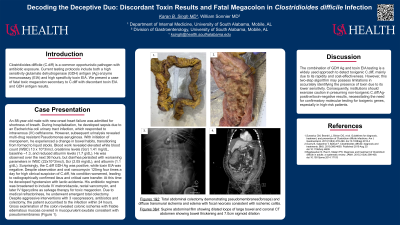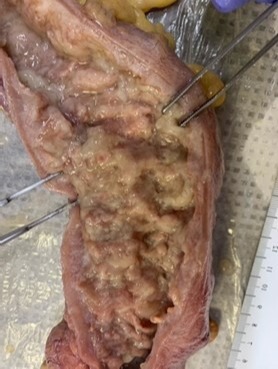Monday Poster Session
Category: Colon
P1703 - Decoding the Deceptive Duo: Discordant Toxin Results and Fatal Megacolon in Clostridioides difficile Infection
Monday, October 23, 2023
10:30 AM - 4:15 PM PT
Location: Exhibit Hall

Has Audio

Karan B. Singh, MD
University of South Alabama
Mobile, AL
Presenting Author(s)
Karan B. Singh, MD1, William Sonnier, MD2
1University of South Alabama, Mobile, AL; 2University of South Alabama College of Medicine, Mobile, AL
Introduction: Clostridioides difficile (C.diff) is a common opportunistic pathogen with antibiotic exposure. Current testing protocols include both a high sensitivity glutamate dehydrogenase (GDH) antigen (Ag) enzyme immunoassay (EIA) and high specificity toxin EIA. We present a case of fatal toxic megacolon secondary to C.diff with discordant toxin EIA and GDH antigen results.
Case Description/Methods: An 88-year-old male with new-onset heart failure was admitted for shortness of breath. During hospitalization, he developed sepsis due to an Escherichia coli urinary tract infection, which responded to intravenous (IV) ceftriaxone. However, subsequent urinalysis revealed multi-drug resistant Pseudomonas aeruginosa. With initiation of meropenem, he experienced a change in bowel habits, transitioning from formed to liquid stools. Blood work revealed elevated white blood count (WBC) 13 x 10^3/mcl, creatinine levels (Scr) 1.41 mg/dL, baseline ~1.3, and reduced albumin levels (1.7 g/dL). He was observed over the next 36 hours, but diarrhea persisted with worsening parameters in WBC (22x10^3/mcl), Scr (2.05 mg/dL), and albumin (1.1 g/dL). Surprisingly, the C.diff GDH Ag was positive, while toxin EIA was negative. Despite observation and oral vancomycin 125mg four times a day for high clinical suspicion of C.diff, his condition worsened, leading to radiographically confirmed ileus and critical care transfer. At this time he developed hypotension with lactic acidemia. His antibiotic regimen was broadened to include IV metronidazole, rectal vancomycin, and later IV tigecycline as salvage therapy for toxic megacolon. Due to medical refractoriness, he underwent emergent total colectomy. Despite aggressive interventions with 3 vasopressors, antibiotics and colectomy, the patient succumbed to the infection within 24 hours. Gross examination of the colon revealed colonic ischemia with friable edematous mucosa covered in mucopurulent exudate consistent with pseudomembranes (Figure 1).
Discussion: The combination of GDH Ag and toxin EIA testing is a widely used approach to detect toxigenic C.diff, mainly due to its rapidity and cost-effectiveness. However, this two-step algorithm may possess limitations in accurately identifying the presence of toxin due to its lower sensitivity. Consequently, institutions should exercise caution in presuming non-toxigenic C.diff Ag-positive/toxin-negative results, necessitating the need for confirmatory molecular testing for toxigenic genes, especially in high-risk patients.

Disclosures:
Karan B. Singh, MD1, William Sonnier, MD2. P1703 - Decoding the Deceptive Duo: Discordant Toxin Results and Fatal Megacolon in Clostridioides difficile Infection, ACG 2023 Annual Scientific Meeting Abstracts. Vancouver, BC, Canada: American College of Gastroenterology.
1University of South Alabama, Mobile, AL; 2University of South Alabama College of Medicine, Mobile, AL
Introduction: Clostridioides difficile (C.diff) is a common opportunistic pathogen with antibiotic exposure. Current testing protocols include both a high sensitivity glutamate dehydrogenase (GDH) antigen (Ag) enzyme immunoassay (EIA) and high specificity toxin EIA. We present a case of fatal toxic megacolon secondary to C.diff with discordant toxin EIA and GDH antigen results.
Case Description/Methods: An 88-year-old male with new-onset heart failure was admitted for shortness of breath. During hospitalization, he developed sepsis due to an Escherichia coli urinary tract infection, which responded to intravenous (IV) ceftriaxone. However, subsequent urinalysis revealed multi-drug resistant Pseudomonas aeruginosa. With initiation of meropenem, he experienced a change in bowel habits, transitioning from formed to liquid stools. Blood work revealed elevated white blood count (WBC) 13 x 10^3/mcl, creatinine levels (Scr) 1.41 mg/dL, baseline ~1.3, and reduced albumin levels (1.7 g/dL). He was observed over the next 36 hours, but diarrhea persisted with worsening parameters in WBC (22x10^3/mcl), Scr (2.05 mg/dL), and albumin (1.1 g/dL). Surprisingly, the C.diff GDH Ag was positive, while toxin EIA was negative. Despite observation and oral vancomycin 125mg four times a day for high clinical suspicion of C.diff, his condition worsened, leading to radiographically confirmed ileus and critical care transfer. At this time he developed hypotension with lactic acidemia. His antibiotic regimen was broadened to include IV metronidazole, rectal vancomycin, and later IV tigecycline as salvage therapy for toxic megacolon. Due to medical refractoriness, he underwent emergent total colectomy. Despite aggressive interventions with 3 vasopressors, antibiotics and colectomy, the patient succumbed to the infection within 24 hours. Gross examination of the colon revealed colonic ischemia with friable edematous mucosa covered in mucopurulent exudate consistent with pseudomembranes (Figure 1).
Discussion: The combination of GDH Ag and toxin EIA testing is a widely used approach to detect toxigenic C.diff, mainly due to its rapidity and cost-effectiveness. However, this two-step algorithm may possess limitations in accurately identifying the presence of toxin due to its lower sensitivity. Consequently, institutions should exercise caution in presuming non-toxigenic C.diff Ag-positive/toxin-negative results, necessitating the need for confirmatory molecular testing for toxigenic genes, especially in high-risk patients.

Figure: Figure 1: Total abdominal colectomy with forceps demonstrating pseudomembranes and diffuse transmural ischemia and edema with focal necrosis consistent with ischemic colitis.
Disclosures:
Karan Singh indicated no relevant financial relationships.
William Sonnier: Abbvie – Speakers Bureau.
Karan B. Singh, MD1, William Sonnier, MD2. P1703 - Decoding the Deceptive Duo: Discordant Toxin Results and Fatal Megacolon in Clostridioides difficile Infection, ACG 2023 Annual Scientific Meeting Abstracts. Vancouver, BC, Canada: American College of Gastroenterology.
